|
|
Search for
The Famous Blonger Bros. |
|

April 2006
| 4/1/2006 |
Lots of ground to cover.
Unmasking The Denver Bunco Ring, Part II
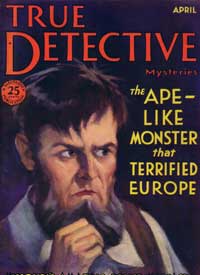
The Vampire Squad
Things will be heating up over at the Grafters Club when the squad shows up.
Koehn relates the story of one witness in the trial, a victim, who was approached by two fetching young lasses who said they were part of the gang's "vampire squad". They gave him $5,000 not to testify, which he accepted, then promptly got on a train for Denver to testify.
Unauthorized Electronic Surveillance
If you read Part I, you know that Detective Koehn planted a microphone ("dictograph") in Lou's office. How often this had been done prior to this investigation in 1922 we can't say, but it was obviously a new technology and none of them were entirely sure of what they were doing.
The microphone was planted in the bell where the chandelier wire passed into the ceiling. Upstairs were two hundred pounds of wet cell batteries that needed to be constantly replenished with fresh acid. Wires were strung in the middle of the night across the street to an office where Koehn was posing as a sock salesman. Good cover. Conversations were not recorded, but had to be transcribed. I wonder if those notes still exist.
While Blonger did sweep his office for a tap on his phone, and looked for microphones, he didn't look in the right place.
Evidence gained in this way was inadmissable, as it would be today. In the end, however, the existence of the microphone was used to intimidate any compromised jurors, who could not be sure if the prosecution knew of their intentions (they didn't).
Here's the American Bank Building in Denver where the bug was planted.
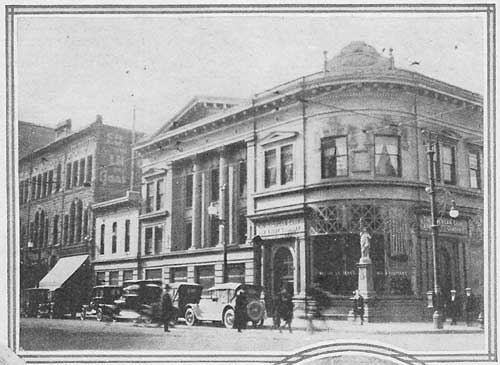
An observation post in a nearby warehouse was used to monitor his movements.
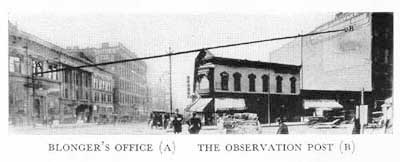
Len Reamey
Interestingly, Koehn calls the bookmaker-turned-informant "Lem Ramy," then says he later lived under an assumed name. Van Cise called him "Les Randle."
We know, of course, that his name was Len Reamey, as reported in the newspapers at the time, and he continued to live under that name.
The Split
Here's the lowdown on how the Blonger gang split things up.
- Steerer 42%
- Spieler 15%
- Bookmaker 5%
- Tailer 2%
- Adolph Duff 18%
- Lou Blonger 18%
A few things from Scott:
Used Viaduct For Sale
Los Angeles Times, March 13, 1911
POLICE BILK BUNCO GAME.
Aged Nebraskan on Verge of Buying Controlling Interest in Denver Viaduct.
[BY DIRECT WIRE TO THE TIMES]
DENVER (Col.) March 12 -- [Exclusive Dispatch.] James McDonough, an aged and wealthy Nebraska rancher, was just on the point of buying a controlling interest in the Fourteenth street viaduct, when Patrolman Higdon happened along. The three confidence men escaped while the patrolman was questioning the rancher. "Your cussed curiosity cost me a pretty penny," the Nebraskan exclaimed. McDonough was to have paid $800 cash for full control of the viaduct. His plan was to erect a toll house at each end and make the traveling public pay tribute.
Laura Blonger
Ogden Standard, September 20, 1893
Miss L. Blonger, one of Ogden's fashionable dressmakers, left over the Rio Grande yesterday to visit the World's Fair and attend her sister's wedding in Denver.
Laura was Simon's daughter. Her sister Emma was married on Oct. 5.
Sam Emerich
Here's Sam Emerich, the trigger-happy Denver detective, conferring with his attorneys after helping to throw an election.
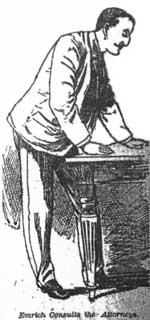
Emerich shot a man who ran while being questioned. Later, he shot a bartender who was apparently helping him clean up after losing a fight. I must say, we've met some rough characters, but this guy gives me the willies.
So it goes. Shortly after the results of the election became known, those who were out on the streets of the city witnessed a comic opera, so that citizens who were unfortunate enough to vote for the "gang's" slate could come and see what they had chosen. Deputy sheriffs Sam Emerick, Leonard de Lue and Fred Harris had hired a wagon and drove around the city to celebrate their victory; that the election was theirs is something voters should already realized ahead of time. On the back of the wagon a sign was attached that read in large letters: "A vote for Burchinell is a vote for Leonard de Lue and Sheeney Sam." Of course they were drunk; otherwise they might not have wanted to openly acknowledge that misery. But so it was. Their slate had won and the hooligans celebrated their victory.
|
| 4/2/2006 |
American Bank
Scott sent over this nifty composite — the American Bank Building, where Lou had his office in 1922, and the photo from Fighting the Underworld showing the location of Van Cise's observation post in a warehouse across the way. Excellent. Click to enlarge.

Notice the Tammen Co. advertised on a building, center.
|
| 4/4/2006 |
Auspicious Moment
Remember — tonight at two minutes and three seconds after 1:00 AM, it will be 01:02:03 04/05/06.
Death of Duff
Did I say feature articles were rare? Scott found another, from 1929, written on the occasion of Kid Duff's suicide. The article looks back at the gang, and wonders where are they now.
This International News Service article appeared in, among other newspapers, the Olean (N.Y.) Evening Times (Dec. 24, 1929) and the Lima (O.) News (Dec. 26, 1929). It probably originated in a Denver newspaper.
$1,000,000 Bunco Ring Recalled By Death of "Kid" Duff
By M. F. DACEY.
DENVER (INS) - When A. W. (Kid) Duff was found dead in his garage recently, the last chapter was written concerning the men who guided the activities of the notorious "$1,000,000 bunco ring" which operated throughout the country with headquarters in Denver until 1922.
Duff appeared in Denver about 1900 and worked in a brickyard for a time. Later he became a well-known figure in Colorado gambling halls.
"Lady Luck" was good and Kid Duff prospered. He became wealthy and his power in politics grew.
The turn in the tide of Duff's fortunes came in August, 1922 when he was the second man arrested in the famous bunco case.
Wouldn't "Squeal"
The trial set a new record for length at that time. Twenty-three men were convicted and sent to the penitentiary for the operation of faked horse races.
"A good gambler wins or loses with no noise," Duff said. He went to the penitentiary and served his four years as a model prisoner and trusty.
A wealthy man, the Duff fortunes turned after his release from prison. He was indicted in Cleveland, Ohio, for using the mails to defraud. The case, however, was never tried.
Duff began to lose a gambling. Always a moderate drinker, he went more steadily into drink as his misfortunes grew, and his beautiful wife filed suit for divorce.
Still believing in Lady Luck he threw his remaining dollars on the green table and intoned the gambler's creed: "Someday I'll get the breaks." He never did.
Hundreds of Denver persons owed Duff a debt of gratitude, his friends recall.
Whenever he had it, anyone was welcome to Duff's money, friends said. He gave thousands of dollars away when he was wealthy.
Were Flying High
Ten years or more ago Duff, Lou Blonger and a score of others were flying high in Denver. They had found an easy way to make a living and money was rolling in. Con games, gambling, fake races and other methods of making money were netting them handsome profits.
Duff was believed to be worth over $200,000. Blonger was even more wealthy. Duff owned two apartment houses and other property. Blonger lived luxuriously at his estate on the outskirts of Denver.
Duff died a pauper - alone and practically friendless.
An old man of nearly 80, Blonger died in the penitentiary at Canon City.
And three others who sought "easy money" in the million dollar bunco game are dead. One of them died while serving his term in the penitentiary.
He was Jack Hardaway, 79, whom the con men called "Pappy." Another con man's gun brought death for George H. Williams, alias Jim Campbell, after he went from Colorado to Minneapolis. Jack Allison, or "Denver Ed," died outside prison walls - penniless.
Dapper Jackie
And there was Dapper Jackie French, third in command to Blonger and Duff among the army of bunco steerers and con men who thrived in Denver until that fateful day of the raid here in late August, 1922.
French served his term in the state penitentiary and was released.
Where he is now nobody knows - but at any moment he may feel the dreaded hand of the law clutching at his shoulder. For Dapper Jackie, who was the adored of Denver society women, is a fugitive from justice. They want him in Florida. They want him in Cleveland. Perhaps he's still fleecing victims through the medium of matinee-idol appearance and slick tongue, but not with that easy nonchalance with which he operated in Denver.
There are four others of the bunco ring who are spending uncertain freedom somewhere. They jumped bond before their trials here. They are Roy Coyne, alias "Slim Blackie"; G. Sullivan, believed to be in Utah; T. J. Brady, alias "Tom Hogan," and John J. Grady, the "perfume kid."
Went To Asylum
Sullivan, incidentally, spent a year or so in the state asylum in Pueblo. Then he was released to be sent to a private sanitarium in Utah. He gave the authorities the slip.
And somewhere is Roy Farrell, expert "spieler" of the bunco ring. He served time in Colorado. California authorities want him. In Los Angeles Farrell gave a "straw" bond for $20,000 - then skipped out. Not a cent could be collected on the bond.
Len Reamey, acclaimed fourth in power of the bunco ring, escaped serving the three to ten year term given to his associates - but at a terrible cost, according to the code.
Reamey turned state's evidence - the paramount crime, they say, in the underworld. Nobody knows where Reamey is. But he's marked for death if crookdom gets him.
News occasionally trickles to Denver of the whereabouts of the remainder of the con men. Here and there, authorities say, they are operating little games, managing to eke an existence by defrauding others.
But they're no longer in "$1,000,000 bunco rings." Money is harder to get than it was for them in those golden days in Denver years ago, when they were respected as money business men.
Three Lucky Ones
"There were three lucky ones," according to Philip S. Van Cise, former district attorney, who crushed the bunco ring in 1922. On the walls of his room is the pictorial and graphic record of the con men - an aggregation of old and young men who fattened on the losses of others for years. At the bottom of the pictured group appear the photographs of three, entitles "Three Lucky Ones - Released Too Soon."
"We found out later that we had enough evidence to send that trio to the pen with the rest, but they were gone," said Van Cise. "They were Roy Yeaman, 'the Blind Man,' Jack Ryan and Puss McCaskey, alias 'J. R. Barry.'"
"Some day they'll slip up and be caught," said Van Cise. "Once a con man - always a con man. They never change. They are regarded as the cream of the underworld."
"You convict them and send them to prison. On release, they go back to the con game, back to easy money, and quite often, back behind prison walls."
Makes me wonder what happened to French. Also puts a personality on Duff.
Additions to books on print.google.com:
The Reign of Soapy Smith, but we were already aware of this book.
The Westerners Brand Book. I'm still trying to get a handle on this. It seems to have been published yearly for a while, filled with stories and lore of the American West. The google citation does not specify what year, but on page 86:
...their total take running into the millions of dollars. District Attorney Philip A. Van Cise [sic] smashed this bunco ring in 1922, and Blonger, then 73 years old, died in the penitentiary.
Although jailed on countless occasions, available records...
Show what? That's all we get.
Over at Colorado's Historic Newspaper Collection, we find:
Jan. 18, 1924, Judge Dunklee rules that Lou will pay $800 toward his own prosecution, rather than the $15,000 Van Cise tried to get by filing liens against Lou's cherry orchard.
|
| 4/5/2006 |
Westerners Brand Book
Yesterday I mentioned a reference on print.google.com to The Westerners Brand Book. Scott did a little sleuthing beyond the single excerpt returned for "Blonger":
...their total take running into the millions of dollars. District Attorney Philip A. Van Cise [sic] smashed this bunco ring in 1922, and Blonger, then 73 years old, died in the penitentiary.
Although jailed on countless occasions, available records...
Searching the same volume for "Denver" gave him:
Volume Fourteen
of the Denver Posse
of the Westerners
Copyright 1959 by the Denver Westerners Inc.
Excellent. The Brand Book was some kind of annual publication. This hit tells us which volume we're after.
Then he got a little creative, searching on "Baggs" and then "Otero." Doc Baggs conned Miguel Otero in Denver in 1882. Longshot? Guess not. An illustration of Baggs is noted as being on page 80, and the reference to Lou is close by on page 86.
Another Baggs reference describes the mixed feelings Denverites had for Baggs, who may be the true archetypal Wild West con man, more than Smith, and certainly more than the Blongers. The decent citizens tried to disapprove, but he had such wit and style and hubris that he was hard to despise.
"Otero" references confirm that the author is telling the story of Doc Baggs and other Denver swindlers, including Lou. Scott believes the article is He Drove the Wild West Wild by none other than Forbes Parkhill, author of Wildest of the (I sense a theme) West, ace reporter for the Post, and already one of our very best sources. The article is twenty-ish pages, and says a lot about Baggs, perhaps nothing new of the Blongers. We'll see. He's ordered a copy, so I guess we'll soon find out.
As he grew ill in prison, Lou was described as suffering from "fatty degeneration" of the heart and liver.
In June of 1896, Horace Tabor was forced by the court to sell his opera house, and the only bidder was — Col. Neil Dennison, a partner with Sam and Lou in the Forest Queen mine, and all-around bad little rich boy.
|
| 4/6/2006 |
Bascomb's Other Letter
Soapy's brother Bascomb was still in the county lockup for the Hughes assault when he wrote to his woman:
Aspen Weekly Times, March 7, 1896
A DENVER SUICIDE
Denver, March 6.—Jessie Smith, mistress of Bascom Smith, brother of the notorious "Soapy," committed suicide this morning by taking morphine. She had a few minutes before received a note from the county jail from Smith, who is a prisoner there in which he had upbraided her for some supposed neglect.
|
| 4/13/2006 |
All-American Bunco Man
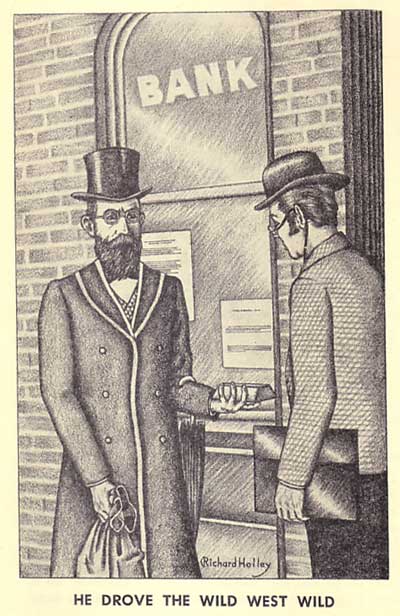
Scott received his copy of the 1958 edition of the Westerners Brand Book, an annual collection of articles on the old west that we found reference to on print.google.com. The article therein, fourteen pages long, only has one short reference to the Blongers:
Baggs returned to Denver occasionally to "skin a sucker." At one time he was reported allied with the notorious bunco man, Jefferson Randolph "Soapy" Smith, in the nineties the dictator of Denver's underworld, of the mining town of Creede, and finally of Skagway, Alaska, where he was killed in a gun duel July 8, 1898.
As king of the con men, Soapy was followed by Lou Blonger, head of an organization of some sixty bunco men responsible for the fleecing of hundreds of victims in Denver and Florida, their total take running into the millions of dollars. District Attorney Philip A. Van Cise smashed this bunco ring in 1922, and Blonger, then 73 years old, died in the penitentiary.
Despite the scanty reference, the article has several points of interest, not the least of which being that it was penned by our old buddy Forbes Parkhill, member of the Grafters Club, and the Post reporter who had the scoop on the Blonger gang arrests — only to have the story held back at DA Van Cise's request. Parkhill may well have been the world authority on Lou Blonger until we came along. Now, we find he wrote this followup to Wildest of the West, titled He Drove The Wild West Wild.
The article delves into the life of Charles "Doc" Baggs, the con man's con man, to my mind.
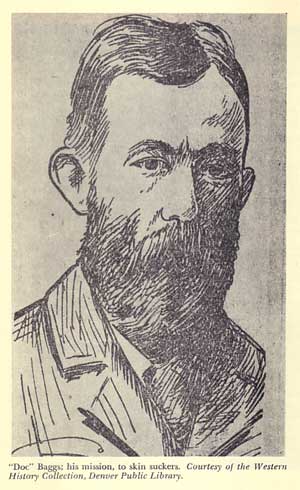
Among pioneer Denver's most fascinating rascals was "Doc" Baggs, adept at selling gold bricks to bank presidents. By turns the populace was shocked, or shaking with laughter at the outlandish activities of this king of the con men, who blandly boasted in the newspapers of his skill at "skinning suckers," and who for six years openly defied Denver's red faced and frustrated lawmen.
Shocked or not, Denver secretly was just a bit proud of his outstanding accomplishments as a bunco artist. When Oscar Wilde visited Colorado on his noted lecture tour in 1882, the Rocky Mountain News intimated that when it came to fluency, "Doc" Baggs could make the distinguished visitor look like thirty cents.
Parkill spills a bit of ink about the so-called Otero con, already a favorite of ours. In 1882, while the Blongers were in Albuquerque, Las Vegas, NM businessman Don Miguel Otero traveled to Denver, to see Oscar Wilde, as it turns out. Baggs and his cronies took Otero for $2400 in a fake policy shop.
The con is notable first and foremost because it played out quite publicly in the papers. What's more, the accounts of the stout efforts of Otero's son, also named Miguel, to recover the funds are a joy to read. It's unsurprising the younger Otero would one day be elected governor of the state.
Of particular interest to us is the relationship between the Oteros and the Blonger Bros. According to a letter apparently written by the younger Otero in his declining days, his father had sent him to assist Wyatt Earp, Doc Holliday and the rest of the Tombstone posse when they arrived in Albuquerque for a short stay after fleeing Arizona. The same letter declares that Sheriff Armijo and Marshal Blonger "watched over" the boys.
As for the con itself, it's interesting to see an early version of the big store con as played by Baggs, innovating on Ben Marks' lottery shop concept.
At the time of the [Otero] visit, lotteries were legal in Colorado and Denver supported many "Policy shops," operating lotteries similar to the modern numbers racket. Colorado derived considerable revenue from the state-operated lottery.
In the lobby of his hotel, Don Miguel encountered a young man claiming to be from his home town. The stranger's innocent appearance failed to mark him as a bunco "steerer." He asked the New Mexican to accompany him to a policy shop to learn if he held a winning ticket.
On the street they met a friend of the young man. He likewise held a lottery ticket and boasted that he knew a system for beating the game. They found the policy shop in charge of a stocky man of middle age-actually "Doc" Baggs, whom the newspapers had described repeatedly as "unquestionably the most successful confidence man in the West." His hair and full beard were dark brown, he wore green glasses, and a finger was missing from his right hand.
At the drawing the young man failed to hold a winning number, but his friend who "knew how to beat the system" won $100. On the next drawing he won again. Pleading that he was short of cash, he proposed that Don Miguel bankroll him in return for a 50-50 split of their winnings. To Don Miguel it seemed a sure thing; an easy way to make a cleaning.
Finally the stranger pyramided his winnings to $2,400, but the venerable policy shop operator told him that he could deliver the cash only if the recipients could establish their credit by producing a similar amount as evidence that they could have paid, had they lost.
Lacking that much cash, the New Mexico bank president signed a five-day note for the $2,400. When he returned the following day to collect his winnings he was informed that the note had been discounted at a local bank and the money paid to Don Miguel's friend. He never saw the "friend" again, or the money.
In a newspaper interview the next day "Doc" Baggs readily admitted the swindle.
"I'm a poor man and Otero is rich. I need the money and he can afford to lose it. He dares not squeal or have me arrested for he is a businessman, has served several terms in Congress and is afraid of publicity."
The check was given to banker Pliny Rice, who paid some fraction on the dollar to Baggs et al. for the note, which he intended, of course, to cash for face value. The younger Otero had him pinched instead.
As for Baggs, Otero, apparently unwilling from the start to publicize his error in judgment — despite the fact that the papers were all over the story — never showed to testify, so Baggs walked.
I also got a kick out of what Parkhill had to say about Baggs and Wilde:
Uncultured Denver was somewhat suspicious of Oscar Wilde's aim to spread culture throughout benighted America. His favorite phrase, "too utterly," aroused the suspicions of rough-and-ready westerners who, accustomed to "Doc" Baggs' con games, saw in the lecture tour an attempt to sell our citizens a cultural gold brick. The following is an excerpt from the "Ode to Oscar," published in the News: When thou talkest of being utter We show up "Windy" Clark who, we will bet Can utter more in the brief circumscribing of a minute than thou canst in a week. If thou dost boast of being too, we will produce Charles Baggs, M. D., who is as too As thou art, and a durned sight tooer.
Too Utterly sounds too much like Totally.
But what about Baggs and the Blongers? There are anecdotal suggestions that these gentlemen may have worked together, but no evidence. Parkhill tells us Baggs left Denver in 1886, two years before the Blongers came to town for good.
But they were in the Denver/Leadville area from 1879 through 1881, and so was Baggs. That they were acquainted can probably be taken for granted.
Interestingly, Baggs first came to the area as a young man looking for gold in 1859, at a time Sam may well have been kicking around Colorado as well.
Here's a perfect example of the twinkle-eyed scoundrel that epitomizes the "All-American bunco man," as Parkhill says he was called.
When Sheriff Mike Spangler jailed the doc on a bunco steering charge, the defendant appeared in court as his own attorney, pointed out that the Colorado statutes contained no such term as "bunco steerer," and won a dismissal.
Thwarted in his effort to keep the "doctor" behind bars, the sheriff directed a deputy, Emil Auspitz, to follow him everywhere and warn every person he met that Baggs was a notorious bunco man.
The "doctor" was delighted by this mark of distinction. Entering his office, he'd switch costumes, emerge disguised, elude his "shadow" and then notify the sheriff that the deputy was loafing on the job.
"Send him to the Windsor Hotel," he invited cordially. "I'll be waiting for him there."
After the deputy had learned how effectively Baggs could disguise himself, one of doc's cappers would point out to the officer some stranger, confiding that it was the bunco man in disguise. Following the innocent man, the deputy would warn every person that the stranger met that this was the notorious "Doc" Baggs, much to the delight of the "doctor," who'd be shadowing the shadow to watch the fun when the indignant stranger punched the deputy's nose.
More to the point, here we see that "code of ethics" that, at least fictionally, distinguishes the true confidence man.
Upon Baggs' return to Denver he learned that one of his henchmen, Tom Daniels, was in jail for robbing Senor Francisco Gonzales while the senor chanced to be drunk. Baggs, described by a newspaper as "this distinguished and oleaginous disciple of Esculapius," was humiliated that Daniels would violate the ethics of his profession, and assured a reporter that money enough can be made by turning tricks on the square basis." The reporter commented, "This sentiment may be forced."
Fact is, most of the con men we've run into would just as soon cheat you bald-faced and then threaten you if you don't just take it like a sucker. Baggs left a different impression.
Yet another interesting swindle:
A bearded miner called upon a prominent attorney, seeking aid in locating a lost partner.
"Several years ago he got into trouble and disappeared after killing a man," was the explanation. "Since that time the mine has become a rich producer. I've been offered several hundred thousand dollars for the property but I can't sell without the signature of my missing partner." He produced a letter confirming the offer to buy the mine.
Displaying a roll of bills totalling several thousand dollars and a money belt stuffed with gold nuggets, he asked the lawyer to recommend a bank where the money could be deposited and the gold left for safekeeping.
Convinced of the stranger's responsibility by this display, the lawyer placed a number of advertisements in western newspapers asking the missing partner to communicate with him. In the course of time he received an answer, the whereabouts of the writer concealed by a "blind" newspaper box number.
Considerable correspondence ensued, the missing partner stating that he feared to make his whereabouts known because of the murder charge against him. He offered to sell his onehalf interest for $50,000 if he could remain in hiding and merely sign the necessary papers.
The lawyer's bearded client was distressed because he lacked the $50,000 necessary to buy out his partner, but offered to put up $25,000 if the lawyer could raise the remainder.
Scenting a chance to make a quick and fat profit, the lawyer put up the $25,000 and never saw his money again. Baggs, of course, was both the client and the missing partner.
What happened to Baggs and his wife, Tout (why not?), in whose name Baggs kept his ill-gotten gains?
Although jailed on countless occasions, available records fail to show that "Doc" Baggs was never convicted of a bunco game charge. In 1915, a Denver newspaper reported that the wily doc, then in his seventies, had "turned his last trick," retiring to his California ranch after skinning a sucker of $100,000.
The article also had a couple of photos of interest:
This is Larimer in the 1880s. Could be a Blonger joint there somewhere.
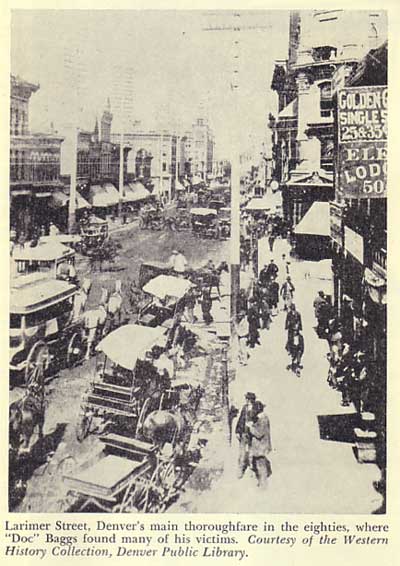
Jeff Smith says of the following photo:.
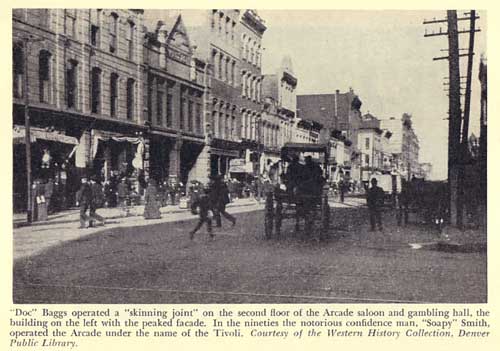
Clay Wilson
The article also describes a partnership between Baggs and one Clay Wilson:
Shortly after Baggs began operating in Denver, a noted gambler called Jim Moon, whose real name was John E. Wilcoxon, sued Baggs and Bull for $5,600 on a promissory note. Shortly afterward Moon was killed by Clay Wilson in a saloon brawl. Baggs testified for Wilson, who was acquitted. For some years thereafter Baggs and Wilson operated bunco games together.
As it turns out, we have met Mr. Wilson before:
Unknown Newspaper, July 26, 1884
Gold Brick Man Collared
A Tough Pair in Toils at St. Louis, Mo.
Clay Wilson and Con W. Caddigan, arrested at St. Louis July 1st with a lot of gambling implements and bunco material in their possession, are well known to the Western Detectives as smart confidence men and thieves. They are members of a gang that has worked Denver and Deadwood and the mining camps of Colorado and New Mexico, and have followed the Mexican Central road into Mexico. Harry Duval, or the "Texas Ranger," was the leader of the band, and Frank Pine, "Jumbo" Clifford, Tom Ashton, and Al Connors, all of whom are now working in the West, were under his orders, with Caddigan and Wilson.
Clay Wilson generally had his headquarters in Denver and Leadville. About two years ago with a companion, he swindled the son of a Leadville Bank President out of $25,000.00 by "gold brick," prepared according to the formula found in his room when arrested. He and Caddigan were afterwards arrested but escaped prosecution but returned part of the money to the victim. Wilson then went to Denver and turned several more confidence tricks, bringing himself into prominent police notoriety. He was a desperate gambler and became the rival of Jim Moon, a Denver sporting man who bore a hard character. Moon, when drunk one night, slapped Wilson in the face and threatened his life, driving him out of the Arcade Saloon, where they were. Wilson returned with a pistol, and standing behind the saloon folding door, emptied a revolver into Moon's body as he was drinking. He was tried and acquitted, but Moon's friend swore vengeance on him, and he left the State, going to Mexico for safety. He has not been heard of in Colorado since. But he has friends in Denver who will come to his aid in his St. Louis trouble.
Con Caddigan is a rascal of similar caliber than Wilson, and has been used by the bunco gang as a "stool pigeon."
He appeared as a confidence man first in Albuquerque, New Mexico, where the gang had their trans-continental rendezvous. Albuquerque was then a new town and the bunco men ran it with a high hand, electing as Justice of the Peace Dan Sullivan, one of their friends, and as Marshal and Constable Milton Yarberry, who was hanged last year, and Con Caddigan. [Don't forget Marshal Sam, between Yarberry and Caddigan.] The operation of these bunco men finally began to hurt the passenger traffic of the Santa Fe road, and the Company determined to drive them out of the territory. So when they cheated Henry Griffith, a Welsh miner, out of $75.00 through the top and bottom trick, Caddigan, Barney Quinn, Billy Knuttall, three of the confidence men, were arrested and put in jail to await indictment, escaping in a few days by the work of their companions outside who bribed the jailer. Caddigan then came to St. Louis and got a variety company which he took to Chihuahua. he played them for several weeks and then deserted them, taking all the money of the company with him. His arrest in St. Louis will afford his victims the liveliest satisfaction.
Caddigan and Bill Nuttall keep popping up. Now Sam and Lou link to Caddigan who links to Wilson who links to Baggs, who links to Soapy, who links back to Sam and Lou, the Blonger Bros., one big happy family.
|
| 4/14/2006 |
All-American Bunco Man
Some feedback from Jeff Smith over at SoapySmith.net:
Damn you, Smith!
Fifty letters! Good Gawd! A gold mine — a real one, that is, not the fake kind.
The Arcade
The Arcade has appeared here before, as in this from 1894, after the new police board closed down the gambling houses:
The same can be said [that the doors were locked] of the Jockey club on Sixteenth street and the several establishments on Lawrence street. An iron screen prevented entrance to the place of Gavin and Austin's and the Arcade had its double doors locked. Further down on Larimer street the doors of the Creede club bore the sign "To Let."
Blonger's, Argyle's and other places on Larimer and Market, including Jeff Smith's Tivoli, were closed tight and so were the three policy shops on Larimer and Fifteenth streets respectively. The branch policy shops throughout the city, with a few exceptions were also closed. There were a few open till noon when the last drawing was held.
At the time, the proprietor of the Arcade was Johnny Hughes — whose assault in 1895 led to Bascomb Smith's incarceration, and contributed to Soapy's dilemma in Denver.
After leaving the Rogers house Jefferson and his brother went to the Casa Bianca saloon and then down Larimer street to the saloon of the Blonger brothers. Here they attempted to create a disturbance, but were persuaded to desist by Officer Kimmel. They left the Blonger saloon and then crossed the street to the opposite side to the Arcade.
In the Arcade they found that they could no longer suppress their liquor-crazed brains and after taking a fresh wad of "fire water," started after "Sheeney" Clarkey [Charley is probably meant here], the barkeeper. He was no match for the pair, and relinquished all efforts to defend himself, when he was knocked to the floor by Jeff's big 45.
Johnny Hughes, one of the proprietors of the saloon, happened in about this time and attempted to quiet Jeff, who was still on the rampage and searching for gore.
Jefferson resented Hughes' interference and turned upon him like a demon. Swish, bang, and the wealthy gambler lay bleeding on the tile floor with three dangerous wounds on his head. Satisfied with their evening's bloody labors Jefferson and Bascom left the saloon and started down Larimer street towards Sixteenth.
Near the corner of Sixteenth and Larimer streets, Chief Goulding and Detective Connors appeared on the scene and placed the pair under arrest.
|
| 4/16/2006 |
Buffalo Bill
I'm looking into Cody a bit, curious about time he might have spent in Denver during the 1890s and beyond. I came across this regarding Cody and Lou's good friend and publisher of the Post, Harry Tammen.
Cody's debts continued to grow and Cody was forced into a series of "farewell appearances." Cody borrowed $20,000 from Harry Heye Tammen, publisher of the Denver Post to cover the cost of printing posters. Forewarned is forearmed. Perhaps, Cody should have been wary of trusting someone who published a postcard bearing the motto: "Live everyday so that you can look every man in the eye and tell him to go to _______." When the show was performing in Denver, Tammen had the show seized by the Sheriff and sold at a Sheriff's sale. Tammen then, holding the debt over Cody's head, forced Cody to appear in a circus owned by Tammen. Judge W. L. Walls of Cody, Wyoming, noted that in the last two years of his life, Cody lost between $140,000.00 and $200,000.00.
Although Cody was ultimately able to disengage himself from Tammen's clutches and the circus, an increasingly arthritic Buffalo Bill was required to continue to appear in various shows, including Miller's 101. In the end Cody was so weak that he could no longer mount his great white horse McKinley and had to ride before the crowds in a carriage.
Here's a basic synopsis of his visits to Denver:
In spring of 1859 Buffalo Bill made his first trip to Colorado as part of the Pikes Peak Gold Rush. He passed through the new town of Denver on his way to the gold fields near Black Hawk where he searched for gold for two months, meeting with little success. On his return to Kansas he stopped in Julesburg, Colorado, where he was recruited to ride in the Pony Express. Most of his time with the Pony Express was spent in Kansas, although occasionally he traveled across northeast Colorado. The Pony Express route did not go to Denver but cut north into Nebraska and Wyoming.
The Pikes Peak rush may well have seduced Sam as well, who supposedly came to Denver in 1857 or 1858. 1859 would have made even more sense. We know that he voted in Colorado in 1861.
Sam is said to have scouted with Cody, but there is no known evidence to this effect.
Buffalo Bill did return to Denver in 1869, ten years after his first time in the town. By then Denver was a growing city where two thieves, who had stolen from the Army, hoped to hide out. General Carr sent scout Buffalo Bill Cody and Captain W. Green to capture the men and return them and the livestock they stole.
Cody returned to Denver another ten years later to perform in a local opera house with the Buffalo Bill Combination. He continued to tour through Colorado, performing at the Central City Opera (still in operation) and at another opera house in Georgetown.
If Cody performed at a theater in Georgetown in 1879 — could it have been Lou's Novelty Theater? A competitor, most likely, but very interesting nonetheless.
After Buffalo Bill organized his Wild West show, he visited Denver and Colorado many times. Altogether, Buffalo Bill performed 35 times in Colorado between 1886 and 1916.
In addition to performing, Buffalo Bill had business dealings in Denver. In 1911 Cody acquired some horse halters from the Gates Tire and Leather Company in Denver. He liked them so well that he provided an endorsement for the product. This gave the fledgling firm such a boost in sales that it became the largest halter manufacturing firm in the U.S. It eventually became Gates Rubber Company.
In 1912 Buffalo Bill needed financing for his show and went to Harry Tammen of Denver for a $20,000 loan. In 1908 he had combined his show with Pawnee Bill's under the title Buffalo Bill's Wild West and Pawnee Bill's Far East. In 1913 the combined show arrived for a Denver performance date at the time the $20,000 loan was due. To their surprise the show was seized by the sheriff's and held to pay off the $20,000 debt. Since Cody did not have that much cash available at the time and Tammen would not extend the loan, Buffalo Bill's Wild West and Pawnee Bill's Far East was sold off at auction in Denver. Continuing to use the debt as leverage, Tammen then forced Buffalo Bill to appear in Tammen's Sells-Floto circus. It was clear that had been his objective all along. In 1915, Buffalo Bill finally got out of his coerced agreement with Tammen.
|
| 4/17/2006 |
Blonger Day's comin, Saturday the 22nd, a third anniversary of sorts.
Deadwood
Scott revisited the indices for the Deadwood newspapers, but found only the one reference to Kitty Blonger and her unclaimed letter. Joe doesn't appear at all. Certainly Lou and Sam might have visited, as Lou's obit states, without being noticed, but if Joe was living there in 1876, he should appear... That's just too bad. I have a gut feeling he was indeed in the area — he was in Salt Lake, supposedly, in '74; he was a lifelong prospector; and his account of the Little Big Horn is so compelling. So where was he then? Maybe just out in the Black Hills.
|
| 4/19/2006 |
Blonger Day
Soapy wonders: "So boys, what are the grand plans for Blonger Day? Greased pole climbing? Find the dollar in a package? Needle in a haystack? Horse Races? Parade?" Good question.
Every year, on the anniversary of the day Scott finally connected our g-g-g-uncle Louis H. Belonger to Lou Blonger, the King of the Bunks, we look back on the year's research, and look forward to the looming questions.
No greased pole climbing, of course. This year it's Chess Boxing. And then the parade.
Buffalo Bill in Elgin
Scott, Jeff, Linda and I grew up in Elgin, Illinois, a river town on the western edge of the Chicago area. Looking into Buffalo Bill, I ran across this:
Telluride Daily Journal, September 16, 1897
BUFFALO BILL'S TENT FELL.
ELGIN, ILL., Sept. 16.—At Buffalo Bill's show to-day, a section of the canvas fell. Three heavy tent poles struck spectators and great excitement reigned. The canvas was removed within a short time, preventing many from smothering. Fred Witte was dangerously injured by a falling pole.
Never knew. Wonder where in town they performed?
In October of 1860, J. H. Hall, from Elgin, stole a bay in Denver. $50 reward.
Jan. 23, 1862:
There is a firm in Elgin, Ill., known as Gray & Hunt. Half their letters come to them "Lay & Grunt."
|
| 4/20/2006 |
Buffalo Bill in Elgin
Scott found a NY Times article about the Wild West show in Elgin. 400 were injured. Farmer Witte suffered serious head injuries, and Mrs. Luther Smith (of 217 National Street) was hurt in the head and shoulders, with internal injuries. A few others were hurt, including a Mrs. Smith, whose head was injured. "She was carrying a baby in her arms, which was afterward found to be in possession of another woman, who had left her child at home and claimed the Smith infant.
|
| 4/22/2006 |

Blonger Day again, April 22.
Three years ago today, Scott finally turned over the right rock, and there was long-lost Uncle Lou. Since then, we have tried on this anniversary to assess the findings of the year past, and take a look at the questions at the top of our list going forward.
In April, we learned a bit about the Blonger businesses in Salt Lake City circa 1874, including Booth's Select Canned Oysters and the Omaha Beer Saloon.
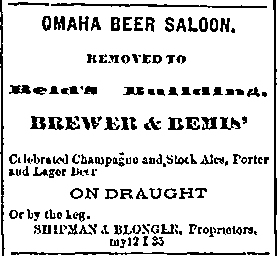
Shipman and Blonger.
[We] call attention to the card of
[Ship]man and Blonger, who have remo-
[dele]d Reid's Building. This firm are
[the ]Sole Agents for the Brewer and
[Bemi]s' celebrated Ales, Porter, and
[Lage]r, of which, every man who likes
...[b]eer, speaks in words of commen-
[datio]n.
In May, Jeff Smith got SoapySmith.net up and running.
In June, we received a Nigerian scam email addressed to Philip Van Cise. Boy did they pick the wrong guy.
A batch of fleeting references to the Blongers hint at discoveries to come regarding their role in Colorado politics:
Breckenridge Bulletin, May 19, 1906
But if this great moral leader, O.K. Gaymon, flunks on us and won't give us lessons just because we have said a mean thing or two about him, the people will simply have to endure our immorality until we can make arrangements for lessons with Lou Blonger of Denver, or some other moral star of the Gaymon-Blonger stripe. It's morality or bust with us.
Durango Democrat, October 15, 1907
As it stands now, the Brewers Association, Bill Evans, and Blonger are the only endorsers of Parson Buchtel's administrative acts. We doubt if his own wife endorses him. —Breckenridge Bulletin
Breckenridge Bulletin, August 1, 1908
Wouldn't Charles J. Hughes, the Denver corporation lawyer, make a daisy colleague of Senator Guggenheim? Where's Lou Blonger?
Creede Candle, February 16, 1924
The Albanians want Harry F. Sinclair, of Teapot Dome fame for king. He should bring home the bacon. Sam Blonger should not despair.
The last is most interesting — Sam was already dead ten years.
Killer prostitute Kitty Blonger appears with dead letters at Aspen in 1889, and Deadwood in 1893 — despite having said at her acquittal in 1888 that she was going back east to the bosom of her family.
We also learned of the crackdown on Denver gambling in 1894, not realizing yet this was connected to the infamous City Hall War.
Aspen Weekly Times, April 28, 1894
Blonger's, Argyle's, and other places on Larimer and Market, including Jeff Smith's Tivoli, were closed tight and so were the three policy shops on Larimer and Fifteenth streets respectively.
But we started to put the pieces together, and getting a handle on the cast of characters in this Denver drama that stretched from the 1880s through the 1920s. Governor Waite and General Tarsney, Chief Armstrong, Soapy Smith, Ed Chase and Johnny Hughes of the Arcade. Detective DeLue, Sheeny Sam, Mayors Speer, Londoner and Bailey, and the list goes on...
Elbert County Banner, Nov. 14, 1902
SPICY NOTES FROM GEORGE'S WEEKLY.
[Selected excerpts from that column]
Apparently a lot of evidence is being collected in Denver for the prosecution of the ballot-box stuffers of that city. But nobody believes that any one will suffer for the crimes they committed in this line except the poor widow who was made a dupe of by scheming politicians, and who admits that she voted oftener than the law allows.
Throw out Arapahoe county and make it unaimous [sic]. It is rotten to the core. The gamblers and bunco steerers were too raw, as Jack Hall's dirty work amply indicates. Throw out this county—decency demands it.
Talk about Republican outrages against the ballot-box! Ye Gods! In the palmiest days of Brady and Connors (and they were the limit in their day) they weren't a circumstance ro Jack Hall and the police force. At Eighteenth and Arapahoe streets on election day we saw repeaters marched up to the polls under the protection of policemen in uniform while Chief Armstrong and Smithwick stood complacently looking on.
When Stimson was nominated we declared openly that it "appeared like a walkover for Stimson." During the past three weeks, however, our readers have noticed we predicted the election of Peabody. Not many of our friends believed it possible, but when we saw the rawness and the ignorance displayed by the Democratic leaders in winking at the dirty work of the Blongers, the Halls and the other criminals, we felt such decent Democrats would revolt, and they did with a vengeance. Then too, every decent Republican got hot and went to the polls to record their protests. Thousands of decent people voted Tuesday who have not voted in years.
Jack Hall voted fourteemn men four times each at one polling place last Tuesday, we are told. This certainly makes the record for "efficient work." Jack deserves hanging for his splendid work. We believe everybody who is entitled to vote ought to be permitted to vote once and have the vote counted. People who sell their votes or repeat ought to be taken out quietly and strung up.
Peabody voted for Stimson and the latter returned the graceful compliment. "Brooks voted for Adams," says the Post, "and Adams went to the polls and voted for himself."
For decades the gamblers held sway in Denver, openly influencing elections with their money and manpower. Arrests on bunko charges were rare, and even those facing jail time rarely served it. And even the Gov. Waite and the Colorado state militia couldn't crush the gambling fraternity's machine.
Finally for June, we heard from Bill Baxter of New Mexico, expert in the mines of the Cerrillos Hills. More to come from Bill...
July was time for WOLA, the convention in Albuquerque of the Western Outlaw-Lawman History Association. We met noted authors and other experts on the Wild West, including Bob DeArment, Mark Dworkin, Bob Alexander and Chuck Hornung.
We visited Santa Fe, Joe's home of many years, Las Vegas, Anton Chico, and of course Albuquerque.
Bill Baxter took us into the desert hills of Cerrillos, where Joe prospected and worked mines for a decade or so.
A typical Cerrillos mine, just a hole that goes eighty some feet straight down.
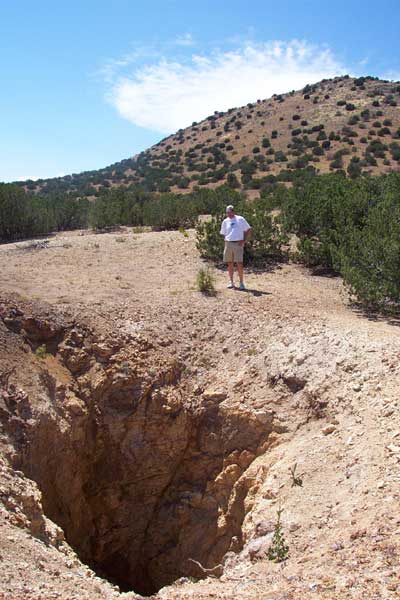
This is where Sam, Albuquerque's fifth city marshal, and brother Lou chased horse thieves, got shot at, and where Lou pistol-whipped poor old Prof. Van Tassel. It's a pedestrian mall now.
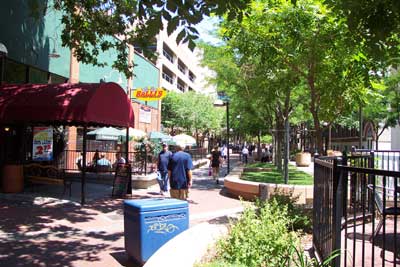
Here is the first balloon ascension in New Mexico, Park Van Tassell's flight of July 4, 1882.
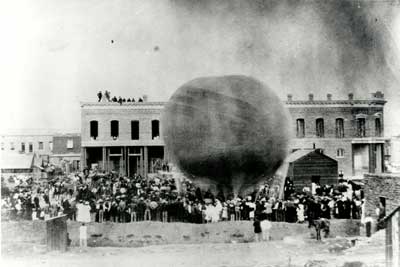
Here I am standing near the spot where Park's balloon took off, on 2nd between Gold and Central. Curiously, the mural in the background is silent on the significance of the location.
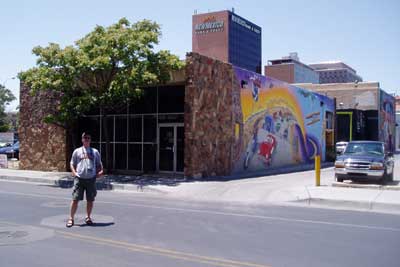
In August, Jeff found a few interesting articles, published after Lou's arrest:
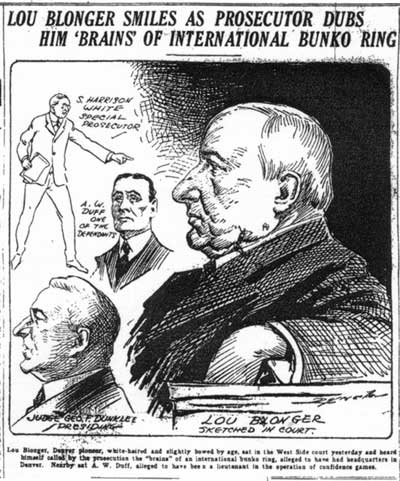
Rocky Mountain News, August 26, 1922
Newspaper records of the history of the two Blongers in Denver are meager.
They reveal little of their activities. The police blotter, on the contrary,
is rich with accounts of the two men and their checkered careers.. First
entries were made about 1881. After that year they follow at irregular
intervals, reaching a climax in the 90's. One of the famous raids made by
the police on the ... tourist's club, 1740 Larimer Street operated by the
"Blonger boys" was that of Feb. 13, 1892. Both Lou and Sam, together with
men named Walker and Phour, were captured and charged with the robbery of C.
I. Tolly, a mining engineer and assayer of Longmont, Colo. Tolly had
complained to the police that he had come to Denver and had been discussing
a money transaction with a friend in the Markham hotel, when two men, who
had been listening, approached him and began talking of mining. On the
pretense of showing him some ore from Creede, they invited Tolly to walk
with them to Larimer Street. As they passed the Tourists club, the story
goes, one of the men asked Tolly if he would mind stepping in for a few
minutes. Tolly stood behind one of the men as they engaged with a some
others in a friendly game of poker. One of the men drew three aces and a
king and turning to Tolly asked him what he would bet on it. Tolly
reluctantly replied that if he were playing he would put $100 on it. The man
on the other side of the table made a pretense of taking the bet. Of course,
the aces and the king lost. The men then insisted that he pay, and when
Tolly attempted to escape they threatened his life if he did not sign over
the money. Tolly made out a check for $100 and went back to Longmont.
Friends urged him to return to Denver and complain to the police. His
complaint resulted in the raid.
Deneen, the Wonder Horse
Deneen, or Denin, was an imaginary horse used by the gang in Denver in fake horse race betting schemes. Never lost a race.
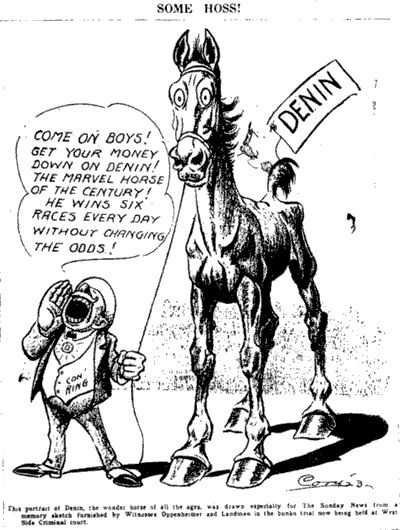
In Lou Don't Trust
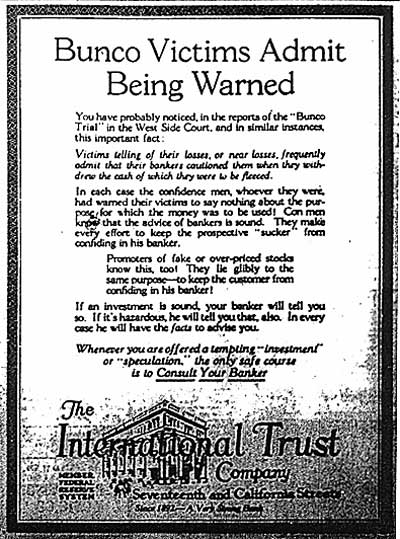
In August we learned a lot about the Blongers' rap sheet, as long as your arm, of course. We learned about Charlie Ronan, gambler and associate of the Mastersons in Dodge, and then part of Sam's posse in Albuquerque. We also got acquainted with Charles Fegenbush, the man who conned Lou Blonger.
Come October, it was Ronan at the Battle of the Plaza, and Sam's troublesome deputies.
In December, we got to know O.K.Gaymon, and we stumbled across Simon's small role in the so-called Ballinger-Pinchot controversy, a political scandal that split the Republican party and paved the way for Wilson to take the presidency.
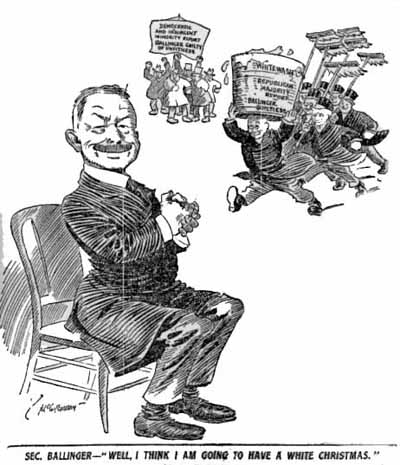
In January, the Grafters Club got a new look. This one still has a lot of additions in the wings. We also took a closer look at Leadville in 1879, and Sam's first trip West around 1860.
We touched on John Maybray's operation in Council Bluffs, and the rise of the mafia and KKK in Colorado after Lou's conviction.
In February, we looked at Ed Chase and Denver's policy shop racket, as well as Wolfe Londoners and the mayors of Denver.
In March, mayors Speer and Bailey, and Detective Sam Emerich.
We also analyzed a letter written from jail by Bascomb Smith, after his arrest for assaulting the Arcade's Johnny Hughes. The letter mentions Sam, and a few other interesting characters, including Col. Neil Dennison and Perry Clay.
A magazine article popped up in True Detective Mysteries, 1932. Written by one of Van Cise's detectives, it tells the story of his surveillance of Lou's office.
So far this April we found an article in the Westerners Brand Book about Doc Baggs that touches on the Blongers, and a bit about Buffalo Bill, Sam's supposed old friend.
That's just a summary, of course, but you can see we were busy. But what about the year to come?
|
| 4/23/2006 |
A Wish List
Where was Lou between 1883 and 1887? In Deming, where he said he was, with same traveling around Colorado, or elsewhere? The 1885 territorial census tells us nothing, and no other clues have surfaced.
What was Sam doing during the Civil War? We know he was in Colorado and California, like Joe said. But doing what, exactly?
We'd love to see Howe's scrapbook of Denver criminal activity.
And where's Sam's badge? Maybe this year...
|
| 4/25/2006 |
Speaking of Elgin
Telluride Daily Journal, August 21, 1914
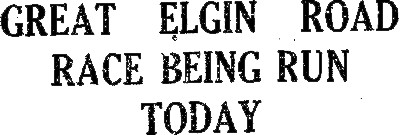
ELGIN, Ills., Aug. 21.—The starter's pistol today sent the star automobile pilots of the country away to day in the first on the annual Elgin races, the classic events in automobile circles in the Middle West. The course lay over nearly nine miles of country roads through the greatest dairying country of the world and fringed by great crowds of spectators who swarmed into Elgin last night and early today from Chicago and surrounding cities. Around 36 laps the drivers will rush their cars for a total of 305.21 miles.
Today's event for the Chicago Automobile Club trophy and prizes worth $3500 sent a field of noted drivers away, but the Elgin National trophy race tomorrow will attract the larger crowd, though the prize money offered is about the same. Motor car traditions have [?] the Elgin National as the big event in the Middle West racing and it has held the larger share of the interest from year to year.
Back in 1970, I attended as a young man a presentation on the Elgin National road race, which ran annually from 1910 until 1920, with a final go in 1933.
I was interested for a while, and even got autographs from Ralph Mulford, winner of the first race, and second place in the first Indy 500, Pete DePaolo, another Indy winner, and Eddie Rickenbacker.
Yes, Eddie Rickenbacker, with whom I was already familiar from an earlier infatuation with the Lafayette Escadrille. Eddie, World War I's most decorated dogfighter, raced in Elgin in 1913, 1914 and 1915 before going overseas.
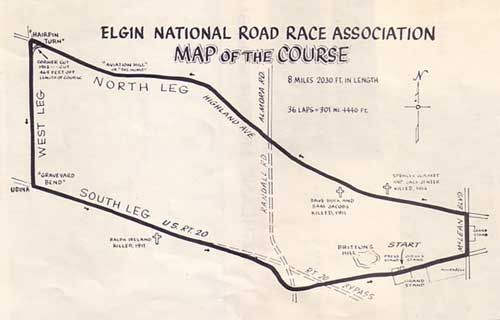
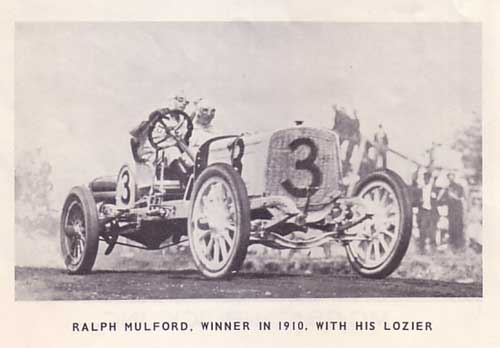
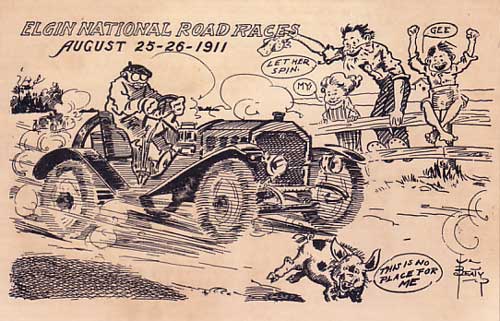
There is a firm in Elgin, Ill., known as Gray & Hunt. Half their letters come to them "Lay & Grunt."
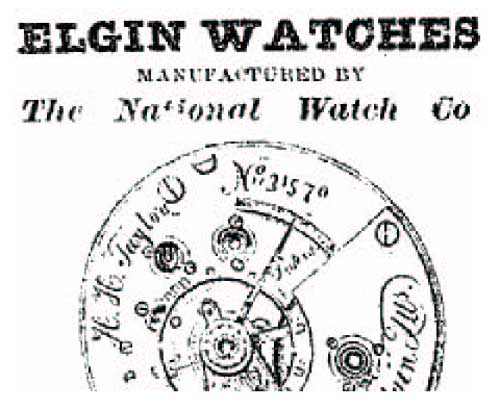
Rocky Mountain News, April 10, 1868
—We invite attention to the advertisement of the American Watch company, at Elgin, Illinois, found under "New To-day." The many favorable notices which the watches of this company have received almost renders any comment of our own, on the success of western skill and enterprise, unneecessary. We do, however, give place to the following extract from an editorial in the Chicago Republican, of April 2. Many others might be given, but this is sufficient: "Lo, a greater than Waltham has arisen on our prairies, being thus known and accepted widely throughout the county. Comparisons are odious when unjust, but we are justified here by the quality of the product of the National Watch company, at Elgin, now within a week or two of the first anniversary of the completion of their first watch. The company now employ two hundred and fifty persons, and turn out sixty watches per day, of their different grades, and it is not too much to say that their watches are accorded the highest place in the trade, and among those whose approbation of the excellencies for the timekeeper is measured by the necessities for extreme accuracy. A watch upon whose movements is to hang the safety of the lives and property entrusted to a flying train must be nice in its adjustment indeed. The model of all roads in pendulum like regularity, is the Pennsylvania Central, whose superintendent has this to say of our Illinois made watches:
"A veteran conductor on the same road, speaking of one of the watches above referred to, says:
"These are testimonials well worth the place we give them, and they belong to a numerous class that constitute the key to the result whereof we set out to speak, the success of this Elgin Watch company."
Well said. And whatever happened to that flying train?
|
| 4/26/2006 |
Denver Behind Bars
Scott just received a couple of books of interest, including Denver Behind Bars: The History of the Denver Sheriff Department & Denver's Jail System, 1858-1956, by Lenny Ortiz. Ortiz was, among many other things, a captain of the Denver Sheriff Department.
A few things of particular interest:
Denver Behind Bars: Doc Holliday in Denver
Ortiz details several scrapes with the law in Denver and Leadville during the mid-Eighties as the gunfighter's fortunes declined. Sam was making the rounds in Colorado during that time. Lou too, maybe.
Denver Behind Bars: Bat and Wyatt
The two are said to have dealt faro in Denver in the late Eighties, at the Arcade and the Central. In 1891, Bat managed the burlesque troupe[!] at the Palace. Bat wed a dancer. Who attended?
Masterson was a deputy sheriff in Denver in 1896 and 1897.
Now here's an interesting tale. As Ortiz says:
Tim Connors who was serving as a polling official was causing problems at the polling booth at 18th and Larimer streets. As Bat arrived to quell the disturbance, Connors attempted to shoot him, but being the crack shot he was, Bat shot Connor's gun out of his hand instead of shooting him between the eyes.
Now this account. You be the judge.
Aspen Weekly Times, April 10, 1897
Shortly after 9 o'clock Bat Masterson and police officer Tim Conners had a shooting match at 1835 Champa street, a polling place. Masterson appeared with a deputy sheriff's commission, and demanded a place in the polls to watch the count. Conners, who had been elected as special constable by the judges, was requested to eject Masterson. He ordered Bat out, and, after some words, Masterson opened fire with his revolver, firing several shots. Conners is said to have replied in kind. Masterson then ran, and has not since been heard from. A number of citizens are scouring the city to capture him. Fortunately nobody was hurt.
There is a LOT more in this book germaine to our subject, including a short bit about Lou and Van Cise, by way of remarking on the deputy sheriff who threw a "drunken orgy" for Lou and his pals while the jury deliberated. Also much info on DeLue, Speer, Bailey, Armstrong, Burchinell, all names discussed here before. This book will help us sort out the roles played by some of our grafters.
Mr. Ortiz's book, we will find, is not always accurate, and I think he's a bit naive at times (or revisionist, perhaps), but there is a lot of information here.
|
| 4/27/2006 |
Denver Behind Bars: Sheriff David J. Cook
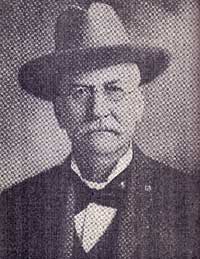
Cook was the founder of the Rocky Mountain Detective Association. Sam and Lou were members in Albuquerque, perhaps only briefly, in 1882. Furthermore, Sam and Lou both seem to have thereafter investigated crimes on occasion. It's taken us some time to understand the nature of this type of detective, and just what the RMDA was. We have read it described as an association of law enforcement officers from across the region.
Profit, however, was also a motive. So were they moonlighting cops, or what? Ortiz chimes in — though he names it an agency, not an association. Perhaps it was known as both.
Ortiz says Cook first opened the RMDA in 1863, an offshoot of the Pinkerton Agency. Then came the war, and then stints as marshal and sheriff. He reopened the association after his tenure as sheriff of Denver ended in 1873. He then accepted an appointment as US Deputy Marshal. "A private detective with unlimited jurisdiction was his goal."
This concept does seem to describe the approach of numerous detectives we have encountered — working as a private investigator, but with official cred to back up your actions, meaning a badge, a badge once carried, a reputation, or even the right connections.
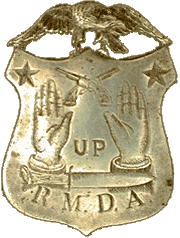
The Mastersons, The Earps, Holliday, Buffalo Bill, Wild Bill, the Blongers, and a host of other old hands of the Wild West could be described in this way. It's a phenomenon that still exists, of course, but the nature of boomtown society created a breed peculiar to the era, a type of man we still read about more than a century later, one who is described in so many of the stories told here. The mudfight over the criminality of Wyatt Earp's actions in Arizona is a perfect example. Was he acting as a cop, or wasn't he? If so, did he have jurisdiction?
Cook was sheriff of Denver again from 1875 to 1880. He was appointed acting police chief by Mayor Sopris, and his first duty was to quell a race riot in Chinatown, around Blake and 16th Street.
Later he served as bailiff of the police courts from 1896 until 1904. Very interesting.
But was he a Grafter? Not sure yet.
|
| 4/28/2006 |
Denver Behind Bars: Denver Sheriffs
- David Cook -- 1875-1880
- Michael Spangler -- 1880-1884
- George H. Graham -- 1884-1886
- Fredrick Cramer -- 1886-1888
- Albert Weber -- 1888-1890
- Elias Barton -- 1890-1891
- William Burchinell -- 1891-1896
- Elias Webb -- 1896-1898
- William Burchinell -- 1898-1899 (appointed)
- Robert Jones -- 1900-1901
- David Seerie -- 1902
Denver Behind Bars: Chief Hamilton Armstrong
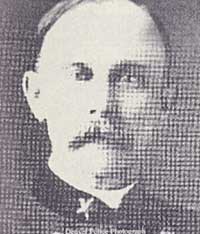
Armstrong has turned up constantly during the Blongers' Denver years. He was appointed chief of police by Governor Waite after his victory in court over the gamblers and their minions at city hall. After serving in a variety of posts through the years, he was chief again in 1920 when Van Cise became DA, and took it upon himself to educate Van Cise in the wicked ways of Denver.
Armstrong appears to be a complex character — the progressive who learns to be pragmatic, who works within the system, who knows where his orders come from (the mayor's office), but does his best to fulfill his duties.
Ortiz mentions a city jail fire November 30, 1901. Armstrong arranged for the transfer of numerous prisoners to the county jail, on foot. Detective Sam Emerich took special charge of a prisoner during the fire. Emerich, we already now, once shot a fleeing prisoner, and later murdered a bartender after a barroom brawl.
In 1902, the Rush amendment gave larger Colorado cities limited home rule powers, a repudiation of Waite's earlier efforts to control Denver affairs. Denver city and county were also carved from Arapahoe County by the act. This meant that County Sheriff Seerie lost jurisdiction over the entire Denver area, and Chief Armstrong was appointed to administer the post as "ex-officio sheriff."
Seerie contested the action, and the case went to the state Supreme Court, but Armstrong had fired all the deputies, and there was no one to run the court.
Armstrong appointed the first Denver County deputies, who served grand jury summons to look into the validity of Armstrong's position as sheriff. In February of 1903 the matter was settled in Armstrong's favor.
So Armstrong was both chief of police of the city of Denver, and sheriff of Denver county, at the same time. But the city and county, in the case, occupy the same area. And so it was decided that the Sheriff's Department of Denver County would be responsible for the prisoners, and the courts.
After serving as ex-officio sheriff, by virtue of his post as police chief, for three years, he won election to the post in 1904. There was a second election in the fall of 1904, and Armstrong lost to Alexander Nisbett. He took the case to the Supremes, and lost. Author Ortiz doesn't know the reason for the second election, but we'll look into it.
In 1911, the mayor was given the power to appoint the sheriff, and he replaced Nisbett with Armstrong.
The next appointee was a man by the name of Dan Sullivan. Could it be the same Dan Sullivan who presided over the Albuquerque courtroom when Sam was marshal, in 1882? That'd be an elderly sheriff — but worth checking. Ortiz says Sheriff Sullivan had been postmaster of Cripple Creek.
Armstrong was chief four times for thirteen years total. He was sheriff three times.
Soapy's Wake
|
| 4/29/2006 |
We Are DEVO
Human people construct this text(s) for investigation. What could this be talking of? m3j645hx
Timid Barkeeps
Let's get one thing straight. Invariably, a saloonkeeper in the movies will be balding, perhaps rotund, and above all skittish and easily intimidated. I ask you, considering the crowd in a western saloon, how could a meek and mild saloonman survive? Not likely. What we know of the Blongers certainly goes against the stereotype, and something tells me they were more the rule than the exception.
Guestbook
Soapy got rid of his guestbook because there were so many spam entries. We recently had a spate. I'll be keeping a closer watch for crud.
Dan Sullivan
Scott reports Albuquerque's Judge Dan Sullivan was Daniel J. The man who would be sheriff of Denver was evidently Daniel M.
In 1912, Sullivan beat sitting sheriff Ham Armstrong in a race for that office. Democrats were roundly defeated by the Citizen's party. Dewey Bailey, Lou's pal who would be mayor in 1922, lost to Henry Arnold in a race for that seat in the same election.
In 1913, Mayor Arnold and Sheriff Sullivan were summarily relieved by Judge Teller. Sullivan was replaced by Nisbett.
|
April 2006
|
Genealogy - History - Gang - Posse - Evening Review
The Grafters Club - Blonger Bros. Fake Restaurant
|
Copyright Notice: Original material copyright 2003-2021 Scott Johnson and Craig Johnson. Other copyrights may apply to materials found herein. Our primary goal is to reintroduce the Blonger Bros. to the lexicon of the Wild West. We therefore encourage the use of our research, provided due credit is given.
https://www.blongerbros.com
|
|



